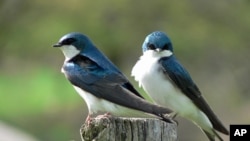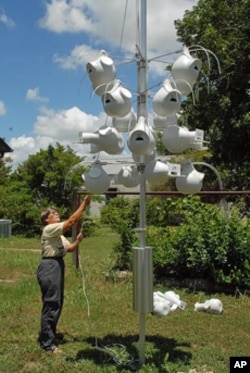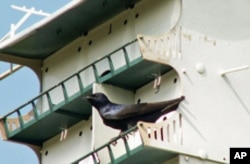Barbara Vinson has a backyard of birds.
Some of them, like the Purple Martin, nest on her property in Central Texas and spend the winter in South America.
Their journey takes them through the Gulf of Mexico. Vinson is heartsick about the oil contaminating the Gulf of Mexico and the fate of her Purple Martins and other migrants.
"I'm afraid that for the next 20 even maybe 30 years we are going to be looking at some really horrific results, particularly for the shore birds, that also migrate," says Vinson.
Call-out for birders
Wildlife biologists continue to monitor species adversely affected over the past three months by the massive oil spill in the Gulf of Mexico.
Since 1965, Cornell University's Laboratory of Ornithology has collected over 400,000 records on most of North America's breeding birds.
Now, the lab has put a call out for bird-watchers across North America, like Vinson, to keep a special eye on nests in their own backyards. Birders provide data on birds in their local environments, species which can include birds that migrate through the Gulf of Mexico, a major flyway.
"We may see effects from the Gulf oil spill on birds, likely far into the future. So it's really important to get information on nesting birds this year and in future years," says NestWatch Project leader Laura Burkholder.
Keeping track
Vinson is one of those citizen scientists who logs data into the lab's online database. Vincent runs a small map publishing business from her home outside of Austin.
Over the past 20 years Vincent and her husband have transformed their 1-hectare backyard into a wooded wildlife habitat to attract birds and butterflies.
She says it's been a good year for her colony of Purple Martins. Twenty-three pairs nested in special aluminum boxes and hanging gourds on her property.
"We monitor how many birds come in. We check every two to five days to see how the nest is progressing, how many eggs are laid, how many eggs hatch and then how the pairs are doing as far as feeding their young and how many actually fled."
Vinson, who watched the last Purple Martin fledgling leave its nest this week, says naturalists like herself, have an important role to play.
"I truly feel that we are not separate from nature, that we are an integral part of nature and that my love of the wilderness and the world around me, tells me that as an integral part of it, I need to respect it and understand it and do what I can to support it."
Vinson hopes the work that brings her such joy will lead to better safeguards for the birds whose survival is threatened by oil spills and other human activities.

















